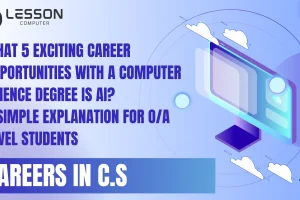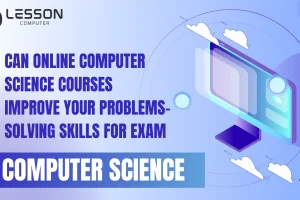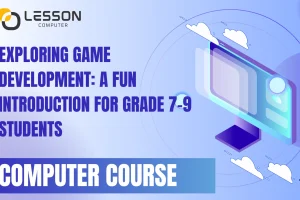
Step-by-Step Guide to Learning Computer Science Online for Grades 7–9 in Mauritius
Computer science is an incredibly dynamic and vital field, especially in our increasingly technology-driven world! For students in Grades 7–9 in Mauritius, exploring online learning options can reveal a wealth of essential skills and open doors to future opportunities in various sectors.
This guide is designed to provide a comprehensive, step-by-step roadmap, helping you to not only understand the fundamentals of computer science but also to develop a passion for it. You’ll discover various topics, such as programming, web development, and data analysis, breaking down complex concepts into easy-to-understand lessons.
We’ll also explore useful online platforms that offer engaging courses, interactive activities, and valuable resources tailored to your skill level. By embracing this journey, you’ll become equipped to tackle real-world problems with innovative solutions, setting you on a path to success in the digital age. With dedication and enthusiasm, you can thrive in mastering computer science and take full advantage of the myriad opportunities that lie ahead!
1. Understanding the Basics of Computer Science
1). What is Computer Science?
Understanding Computer Science: A Journey into a Digital World
What is Computer Science?
At its core, computer science is the study of computation and information. It encompasses everything from programming and algorithms to the architecture of computers themselves. This dynamic field is ever-evolving, pushing the boundaries of what technology can achieve.
Why is Computer Science Essential in Our Daily Lives?
In today’s fast-paced world, computer science plays a pivotal role in shaping our everyday experiences. From the smartphones we rely on to connect with loved ones, to the algorithms that personalize our online shopping and streaming services, it’s hard to imagine life without the influence of computer science. It empowers us to solve problems, enhance productivity, and explore new horizons.
Revolutionizing Industries Through Innovation
The impact of computer science stretches across various sectors—from healthcare and finance to education and entertainment. In healthcare, for instance, it aids in the development of life-saving technologies and efficient management systems. In finance, algorithms analyze market trends to guide investment strategies. This versatility showcases the transformative power of computer science, making it a cornerstone of modern society.
Dive into the world of computer science and discover how it’s not just a field of study, but a crucial element that enriches our lives and propels industries forward.
2). Benefits of Learning Computer Science Early
Encouraging logical thinking and problem-solving helps students succeed in school and their future careers. It also sparks creativity and innovation, which can lead to exciting opportunities!
3). Introduction to Key Concepts
This overview covers essential concepts in the field of computer science, including programming, algorithms, and data management. It begins with an introduction to the fundamentals of hardware and software, providing a solid grounding for understanding how these components interact. Additionally, it explores the significance of networks and the internet, highlighting their roles in facilitating communication and data exchange in today’s digital landscape.
4). Setting Learning Goals
Identifying specific areas of interest, such as coding, robotics, or web development, is crucial for personal and professional growth. Once these interests are established, it is important to set both achievable short-term and long-term goals to provide direction and motivation. Additionally, tracking progress along the way is vital, as it helps to maintain focus, evaluate growth, and make necessary adjustments to the learning process.
2. Choosing the Right Online Learning Platform
1). Popular Platforms for Computer Science Learning
Unlock Your Learning Potential with our online tuition courses available on Lesson Computer
Discover the ultimate online tuition experience tailored just for Mauritius! Dive into our platform where you can explore a variety of local online tuition options. We make it easy to compare features and costs, ensuring you find the perfect match for your educational needs. Whether you’re looking to boost your grades or master a new skill, LessonComputer.mu has you covered! Start your journey to success today!
2). Evaluating the Curriculum
- Evaluating whether the content is suitable for different age groups.
- Making sure it aligns perfectly with school curricula.
- Seeking out exciting hands-on projects and interactive exercises!
3). Interactive Tools and Resources
- Check if the content is suitable for different ages.
- Make sure it matches school curricula.
- Look for engaging hands-on projects and exercises.
4). Free vs. Paid Platform
· Exploring the Benefits of Free Learning Platforms
Free learning platforms offer a wide range of advantages, including accessibility to educational resources, diverse course offerings, and the opportunity for self-paced learning. These platforms often help bridge the gap for individuals who may not have the financial means to access traditional education.
The Advantages of Investing in Paid Courses
While free learning options are valuable, investing in paid courses can provide additional benefits such as structured learning paths, personalized feedback from instructors, and recognized certifications. Paid courses may also offer a more comprehensive curriculum and resources that enhance the learning experience.
Scholarships and Discounts for Mauritian Students
Mauritian students can take advantage of various scholarships and discounts offered by educational institutions and online learning platforms. These financial aids can significantly reduce the cost of education, making it more affordable for students to pursue their academic and professional goals.
3. Setting Up the Ideal Learning Environment
1). Creating a Study Space
Selecting a quiet and comfortable space is crucial for productivity and well-being. It’s important to find an area that minimizes noise and interruptions, allowing you to concentrate fully on your tasks.
Ensuring adequate lighting is vital, as it can significantly impact your comfort and performance. Natural light is preferable, but if that’s not available, opt for warm, adjustable artificial lighting that reduces eye strain. Additionally, incorporating ergonomic design elements, such as an adjustable chair and a desk at the right height, can enhance your posture and reduce discomfort during long periods of work.
To improve focus, actively reduce distractions in your environment. This can include silencing phone notifications, keeping your workspace organized, and using noise-canceling headphones if necessary. Creating a clutter-free zone will not only help maintain concentration but also promote a sense of calm.
2). Technical Requirements
When preparing for your work or study tasks, it’s important to ensure you have the following essential devices: a laptop, desktop, or tablet that meets your performance requirements. Each device should be equipped with the necessary specifications to handle the software and applications you’ll be using.
· Additionally, a reliable internet connection is crucial. This means having access to a stable Wi-Fi network or an Ethernet connection to avoid interruptions during online activities, such as video conferencing, cloud-based work, or research.
· Lastly, make sure to install all necessary software or applications before starting your tasks. This may include productivity suites, communication tools, and any specialized programs relevant to your work or study, ensuring everything runs smoothly when you need it. Taking the time to prepare your setup properly will enhance your efficiency and effectiveness.
3). Scheduling Study Time
Establishing a Consistent Study Schedule:
Creating a specific study timetable can greatly enhance productivity and retention of information. Designate particular hours each day dedicated solely to studying, ensuring these periods are free from distractions. Consistency helps reinforce a routine, making it easier to focus and absorb material over time.
Managing Schoolwork Alongside Online Learning:
Navigating the demands of both traditional schoolwork and online learning can be challenging. It’s essential to prioritize tasks based on deadlines and difficulty levels. Consider using digital tools, such as planners or apps, to track assignments and exam dates. Establish a balanced approach by allocating time for both forms of learning while remaining flexible to adjust as needed.
Recognizing the Importance of Regular Breaks:
Taking regular breaks during study sessions is crucial for maintaining mental sharpness and preventing burnout. Implement techniques like the Pomodoro Technique, where you study for 25 minutes and then take a 5-minute break. Longer breaks should also be planned after extended study periods to recharge. This practice not only boosts productivity but also enhances overall well-being and focus.
4). Parental Support and Guidance
Fostering Steady Development:
Actively promoting ongoing improvement and growth in skills and knowledge, ensuring that progress is both consistent and measurable over time.
Assisting with Technical Challenges:
Providing support and guidance in troubleshooting and resolving technical difficulties, ensuring users can smoothly navigate and utilize their devices or software effectively.
Supervising Screen Time:
Keeping a close eye on the amount of time spent in front of screens, while actively encouraging a balanced lifestyle that incorporates offline activities and promotes overall well-being.
4. Starting with Beginner-Friendly Topics
1). Introduction to Programming
Programming is the process of designing and building executable computer software to accomplish a specific task. For beginners, it’s essential to understand various coding languages that can help facilitate this process. Two popular languages that are accessible for newcomers are Scratch, a visual programming language that uses blocks for coding concepts, and Python, known for its simplicity and readability.
Once you have a grasp on these languages, the next step is to write your first program. This foundational experience will give you insight into the logic of coding and help you build confidence as you start your programming journey..
2). Understanding Algorithms
Algorithms are systematic procedures or sets of rules that are followed to solve a problem or complete a task. They are foundational to computer science and programming, guiding the decision-making process through a step-by-step approach.
In our daily lives, we encounter numerous examples of algorithms, often without even realizing it. For instance, following a recipe in cooking is a practical example, where specific steps must be adhered to in order to achieve the desired outcome. Similarly, navigation apps use algorithms to determine the fastest route to a destination by evaluating various options and conditions.
To visualize algorithms and understand their structure better, we can create simple flowcharts and pseudocode. Flowcharts use symbols and arrows to represent the flow of steps in a process, making complex algorithms easier to understand at a glance. Pseudocode, on the other hand, involves writing down the algorithm in a format that resembles programming code but is more informal and human-readable. This approach allows for clear communication of an algorithm’s logic without the intricacies of actual coding syntax.
3). Basics of Hardware and Software
- Identify the main hardware parts: the Central Processing Unit (CPU), Random Access Memory (RAM), and storage devices.
- Understand the two types of software: system software and application software.
- Learn how hardware and software work together.
4). Exploring Digital Citizenship
In today’s digital landscape, it is imperative to prioritize online safety and uphold the highest standards of digital etiquette. Navigating the internet responsibly is not just essential; it is a necessity for everyone.
Cyberbullying is a pervasive threat that impacts individuals across all age groups, particularly the youth. It is critical to recognize and address the signs of cyberbullying proactively. Furthermore, data privacy cannot be overlooked; individuals must take decisive action to protect their personal information from unauthorized access and exploitation.
To ensure a secure online experience, utilizing effective tools for safe internet browsing is non-negotiable. Privacy-centric browsers, reputable VPNs, and robust security software are vital defenses against potential threats. By leveraging these tools, individuals can confidently navigate the internet, safeguarding both their privacy and well-being.
5. Progressing to Intermediate Topics
1). Introduction to Web Development
Fundamentals of HTML and CSS: Gain a foundational understanding of HTML and CSS, the building blocks of web development.
Developing Basic Web Pages: Learn how to create straightforward web pages that effectively showcase content and design.
Exploring JavaScript’s Functionality:Discover the important role of JavaScript in enhancing user interaction and functionality on websites.
2). Fundamentals of Data Science
What is Data?
Data refers to raw facts, figures, and information that can be gathered through various means such as observation, measurement, and research. It serves as the foundation for analysis and decision-making in numerous fields, including science, business, and technology.
Collecting and Organizing Data:
The process of data collection involves systematically gathering information relevant to a specific question or objective. Once collected, data must be organized in a meaningful way, often using tools like spreadsheets or databases, to facilitate analysis and interpretation. This step is crucial as it helps to identify patterns, trends, and outliers that can provide valuable insights.
Introduction to Visualizing Data Using Charts:
Visualizing data is the practice of representing information graphically, which can make complex datasets easier to understand and interpret. Charts, such as bar graphs, pie charts, and line graphs, are powerful tools for conveying trends and comparisons at a glance, enabling audiences to grasp the significance of the data quickly and effectively.
3). Robotics and Automation
What is Robotics?
Delve into the fascinating realm of robotics, where machines are designed to assist, automate, and perform tasks that enhance our daily lives. Explore the principles that drive this innovative technology and its applications in various industries.
Basics of Sensors and Actuators:
Learn about the essential components that make robots function—sensors that gather information from the environment and actuators that bring the robot’s actions to life. Discover how these elements work together to create responsive and intelligent machines.
Building Simple Robotic Projects:
Unleash your creativity as you engage in hands-on projects that allow you to apply your knowledge. Start with simple robotic creations, gaining practical experience while having fun and sparking your interest in the world of robotics!
4). Introduction to Cybersecurity
Cybersecurity refers to the practices and measures taken to protect computer systems, networks, and sensitive data from potential threats and attacks.
Recognizing Common Threats:
It’s essential to be aware of various cybersecurity threats, such as viruses and phishing scams, which can compromise the security of devices and data.
Basics of Protection:
Implementing fundamental strategies to safeguard your devices and data is crucial. This includes using strong passwords, regularly updating software, and installing security features to enhance overall protection.
6. Practising Hands-On Projects
1). Building a Simple Game
When it comes to game development, there are various tools available that cater to different needs. Two popular platforms are Scratch and Unity. Scratch is an excellent choice for beginners, allowing users to create simple games with a visual programming approach. On the other hand, Unity offers a more advanced environment for professional developers, supporting 2D and 3D game creation.
In the game development process, designing characters and levels is crucial. This involves conceptualising unique characters with distinct traits and creating immersive game environments that enhance the overall player experience. Additionally, incorporating interactive elements, such as puzzles or dynamic effects, is essential for engaging players and making the game play enjoyable and memorable.
2). Developing a Personal Website
Planning the Layout and Content:
Begin by outlining the structure of your website and determining the type of content you wish to include. This will help in organising the information effectively for your audience.
Using HTML and CSS to Build Pages:
Utilise HTML (Hyper Text Markup Language) to create the framework of your web pages, and CSS (Cascading Style Sheets) to enhance their visual presentation. This combination allows for a well-structured and visually appealing site.
Publishing the Website Online:
Once your website is built and tested, it’s time to make it accessible to the public by publishing it on the internet. This step typically involves selecting a hosting service and registering a domain name. By following these steps, you can create a functional and attractive website.
3). Data Analysis Project
· Gathering information can be done through methods such as surveys or experiments, which provide valuable data for analysis. Analyzing this data often involves utilizing spreadsheets or coding tools to uncover trends and insights. Finally, effectively communicating the findings is essential, and this can be achieved by presenting the results through various visual formats, making the information more accessible and understandable.
4). Creating an Educational App
· Defining the Purpose of the App:
Clearly identify and articulate the specific objectives and intended functions of the application to ensure it meets user needs effectively.
· Utilizing User-Friendly Prototyping Tools:
Employ accessible prototyping tools to create an initial version of the app, allowing for visual representation and interaction without extensive coding knowledge.
· Conducting Testing and Sharing the App:
Implement thorough testing to gather user feedback, followed by sharing the app with a wider audience to further refine its features and usability..
7. Joining Online Communities
1). Benefits of Collaborative Learning
Engaging in collaborative efforts fosters the exchange of knowledge and ideas, enhancing the learning experience. Participating in group projects promotes teamwork and allows individuals to explore diverse perspectives. Additionally, these collaborative activities are essential for developing effective communication skills, which are vital in both academic and professional settings.
2). Forums and Groups for Young Learners
- Engaging in online coding clubs is a great way to enhance your programming skills and connect with like-minded individuals. These clubs often offer collaborative projects and resources that can help deepen your understanding of coding principles.
- Participating in discussion forums allows you to exchange ideas, ask questions, and gain insights from others in the coding community. These platforms can be valuable for troubleshooting and exploring different programming concepts.
- Additionally, following educational YouTube channels dedicated to coding can provide you with visual and practical learning experiences. Many creators offer tutorials, coding challenges, and insightful content that can supplement your software development journey.
3). Participating in Competitions
In Mauritius, there are various coding and robotics competitions that provide a platform for participants to demonstrate their skills. These events often include global challenges, such as the Hour of Code, which aim to promote computer science education and engage learners worldwide. Participating in these competitions is vital, as it not only allows individuals to showcase their talents but also helps to build confidence and foster a community of tech enthusiasts.
4). Seeking Mentorship
Engaging with mentors in online communities can provide valuable insights and support for professional growth. By connecting with experienced professionals, individuals can gain practical knowledge and learn effective strategies for navigating their careers. Additionally, receiving career guidance offers numerous benefits, including enhanced skill development, better decision-making, and increased confidence in pursuing career goals.
8. Tracking Progress and Assessing Skills
1). Setting Milestones
To effectively pursue goals, it is essential to break them down into manageable tasks. This approach allows for clearer focus and progress tracking. Additionally, celebrating small achievements along the way can boost motivation and reinforce positive behavior. It is also important to remain flexible and adjust goals as needed to accommodate changing circumstances or new insights.
2). Taking Online Quizzes and Tests
Regular assessments offer several advantages, including:
- Access to free quizzes on programming and a variety of other subjects, which can enhance learning opportunities.
- Utilizing assessment results to pinpoint specific areas that require improvement, allowing for targeted development and skill enhancement.
3). Building a Portfolio
- Organizing and preserving completed projects is essential for future reference and reflection on achievements.
- Chronicling the learning journey provides valuable insights into personal growth and skill development over time.
- Distributing work on platforms such as GitHub enhances visibility and collaboration within the community, allowing for feedback and professional networking.
4). Seeking Feedback
Seeking guidance from teachers or tutors can provide valuable insights and strategies for improvement. Additionally, receiving constructive criticism from peers is an effective way to gain different perspectives on one’s work. Utilizing this feedback is essential for refining skills and fostering personal growth in any learning endeavor.
9. Overcoming Challenges in Online Learning
1). Staying Motivated
- Establishing clear, personal motivations for learning can significantly enhance engagement and perseverance in the educational process.
- Incorporating regular breaks into study routines is essential to prevent burnout and maintain overall productivity.
- Implementing a reward system for achieving specific milestones can be an effective strategy to motivate progress and sustain enthusiasm throughout the learning journey.
2). Managing Screen Time
· Emphasize the Importance of Physical Activity and Hobbies:
Engaging in physical activities and pursuing hobbies is essential for maintaining overall well-being. These activities not only enhance physical health but also improve mental clarity and emotional stability.
·Establish Daily Screen Time Limits:
It is beneficial to set specific boundaries on daily screen time. This practice can help mitigate excessive usage and encourages a more balanced lifestyle, allowing for increased engagement in offline pursuits.
3). Dealing with Technical Issues
When managing assignments and projects, it’s essential to ensure that you have reliable backups in place. This can help prevent loss of work due to unexpected issues. Additionally, utilizing online support forums can be an excellent way to seek assistance and gather insights from others who may have faced similar challenges. In situations where internet access is limited or guidance is needed, offline resources can serve as valuable tools for information and support.
4). Handling Difficult Topics
When tackling complex subjects, it can be helpful to break them down into smaller, more manageable components. This approach allows for a clearer understanding of each individual part. Additionally, revisiting tutorials and guides can reinforce knowledge and clarify any confusing concepts. Finally, seeking personalized assistance from tutors can provide targeted support and address specific questions, enhancing the learning experience.
10. Planning for Advanced Learning
1). Exploring Advanced Programming Languages
- Explore the key features and applications of Python, Java, and C++.
- Discover a curated list of the best resources available for mastering advanced coding techniques.
- Learn about the methodologies and tools necessary for building complex applications in these languages.
2). Diving into Artificial Intelligence
· Introduction to AI and Machine Learning: An Overview
Understanding the foundational principles of artificial intelligence (AI) and machine learning (ML).
· Engaging AI Projects for Young Learners
Exploring exciting and interactive projects designed to introduce young minds to the world of AI.
· Practical Applications of AI in Everyday Life
Examining how AI is utilized across various industries and its impact on our daily activities.
3). Preparing for Future Exams and Careers
- Ensuring that educational content aligns with the O/A Level syllabi to meet academic standards.
- Investigating various career opportunities in the field of computer science.
- Strategizing and preparing for further academic pursuits in Mauritius or internationally.
4). Participating in Internships and Workshops
Exploring local opportunities in Mauritius can be highly beneficial for personal and professional growth. Engaging in hands-on experiences allows individuals to gain practical skills and apply theoretical knowledge in real-world settings. Moreover, learning from experienced professionals in the field offers valuable insights and mentorship, fostering deeper understanding and career development.
11. Exploring Online Computer Science Websites
1). Top Website for Grades 7-9
· Lesson Computer.mu:
if you wanted to be skilled in your computer science subject then just enroll in the online courses provided by this site. They not only teach about computer science but they provide quality and affordable education.
2). Features to Look For in a Learning Website
- The platform features an easy-to-navigate interface, ensuring users can find what they need with minimal effort. It offers age-appropriate lessons and tutorials tailored to different learning stages. Additionally, the interactive activities include engaging quizzes, games, and coding challenges that enhance the learning experience.
- The presence of tools for tracking progress is essential for effective monitoring and evaluation. These tools enable users to measure their advancements over time, set goals, and identify areas for improvement.
3). Mauritius-Specific Learning Platforms
Websites that provide content specifically designed to align with local school curricula can be valuable resources for students and educators. Additionally, platforms that offer bilingual options, such as courses in Computer Science and French, can enhance learning opportunities for diverse learners. Furthermore, resources from local educational organizations and tutors can offer targeted support and enrichment tailored to the needs of the community.
4). Incorporating Website Learning into Daily Practice
To optimize learning, consider dedicating 30 minutes to an hour each day for lesson exploration. Engaging in interactive projects and exercises can also enhance understanding and retention of the material. Additionally, regularly reviewing progress with parents or teachers can provide valuable feedback and support.
FAQs:
While there is no fixed age, students in Grades 7–9 are at an ideal stage to start learning computer science as they can grasp basic concepts and develop logical thinking.
No, most online platforms are accessible on standard computers or tablets. Ensure a reliable internet connection and the required software.
Students should aim for 30 minutes to an hour daily, balancing this with schoolwork and other activities.
Yes, several tutors and platforms in Mauritius offer personalized online tuition tailored to the local curriculum.
Absolutely! Beginner-friendly platforms like Scratch and Code.org are designed for students with no prior experience, making it easy to get started.
Parents can track progress through platform dashboards, review completed projects, and have regular discussions with their children about what they’ve learned.
Encourage them to revisit tutorials, seek help from forums or tutors, and practice consistently. Breaking topics into smaller sections can also help.
Conclusion:
Learning computer science online presents an exceptional opportunity for students in Grades 7–9 in Mauritius to acquire vital skills that will be instrumental in shaping their future career paths. The digital landscape offers numerous platforms, such as lesson computer.mu, which specifically cater to the educational needs of young learners. These platforms provide engaging curricula and a variety of resources that can make learning interactive and enjoyable.
To maximize the benefits of online study, it is crucial to create an effective learning environment at home. This includes setting up a dedicated study space that is free from distractions, ensuring access to reliable internet, and having the necessary tools such as a computer, software, and educational materials readily available. Additionally, establishing a consistent study schedule can help students maintain focus and motivation.
Hands-on projects play a vital role in reinforcing theoretical knowledge. Students are encouraged to undertake practical assignments, such as coding games, building websites, or even developing simple applications, which not only solidify their understanding of concepts but also ignite their creativity. These projects can serve as a portfolio to showcase their skills to future educators or employers.
With support from parents, teachers, and mentors, young learners can comfortably navigate the challenges that accompany online learning. These guiding figures can help them set realistic goals, encourage perseverance, and celebrate milestones in their learning journey. Regular feedback and progress tracking are essential elements that contribute to students’ growth and confidence in their abilities.
Although the prospect of mastering computer science might seem overwhelming at first, it can transform into a fulfilling and enriching experience when approached with consistency, curiosity, and a willingness to learn. Over time, students will not only grow their technical proficiencies but also develop critical thinking and problem-solving skills that are invaluable in today’s technology-driven world.



